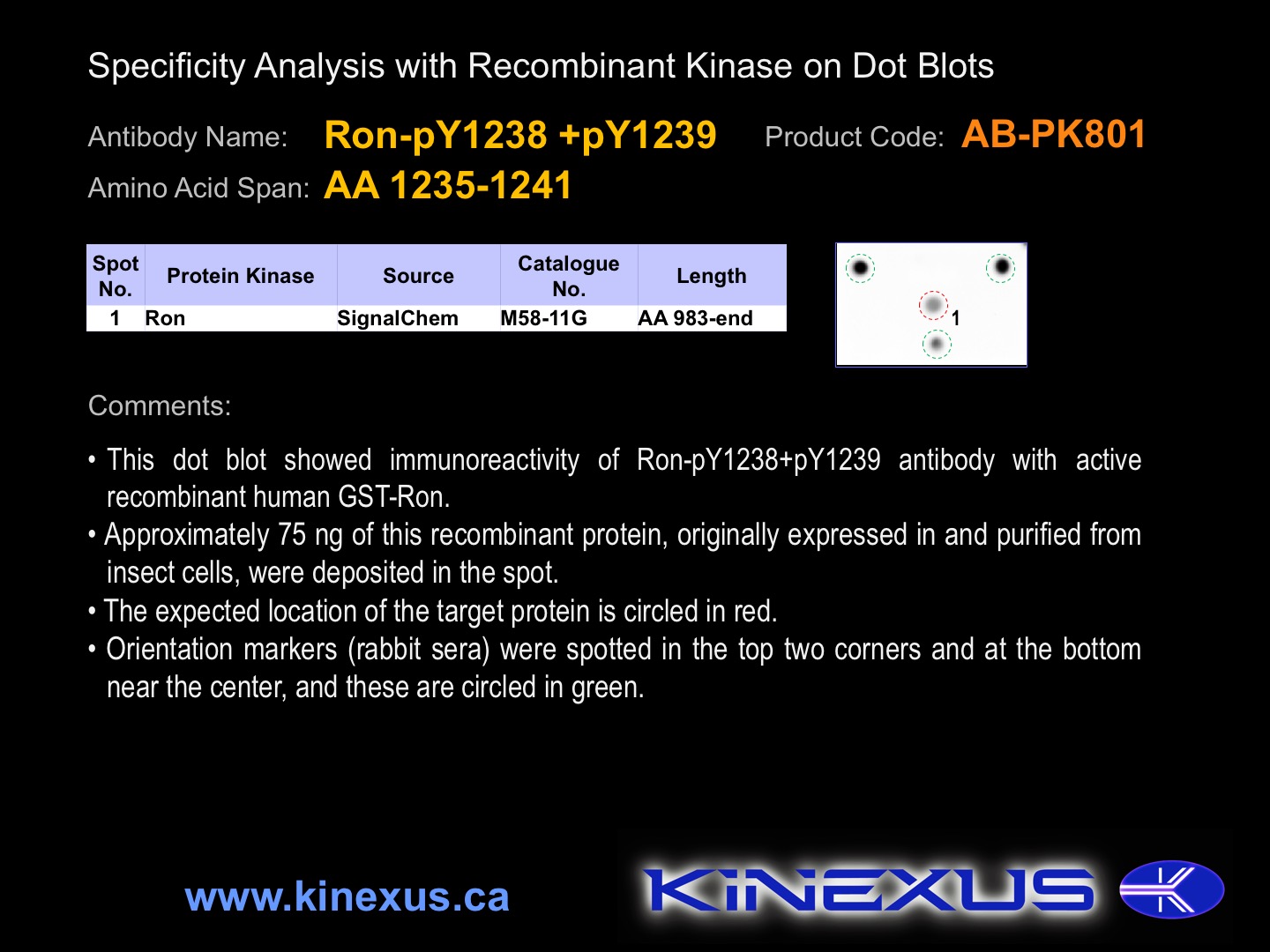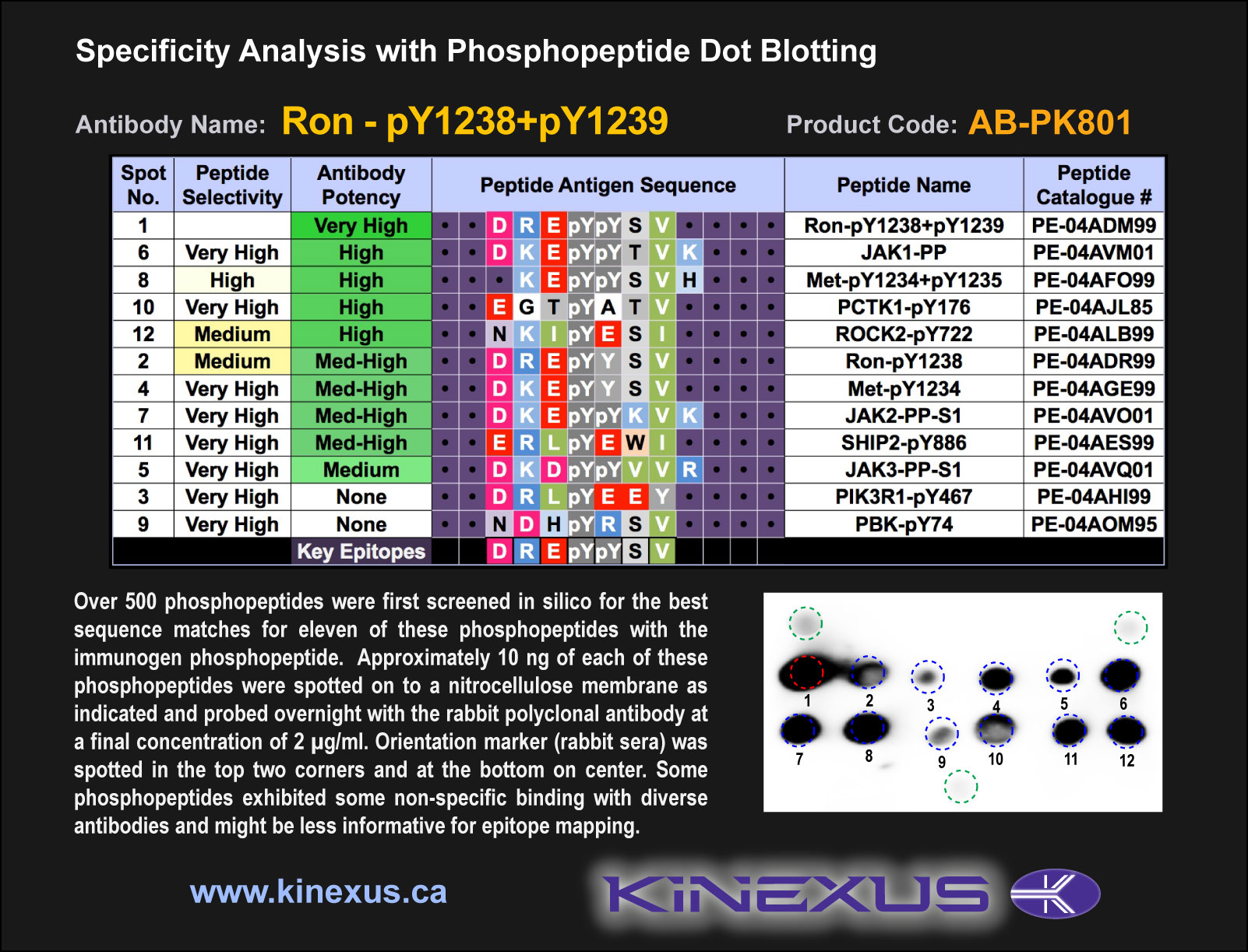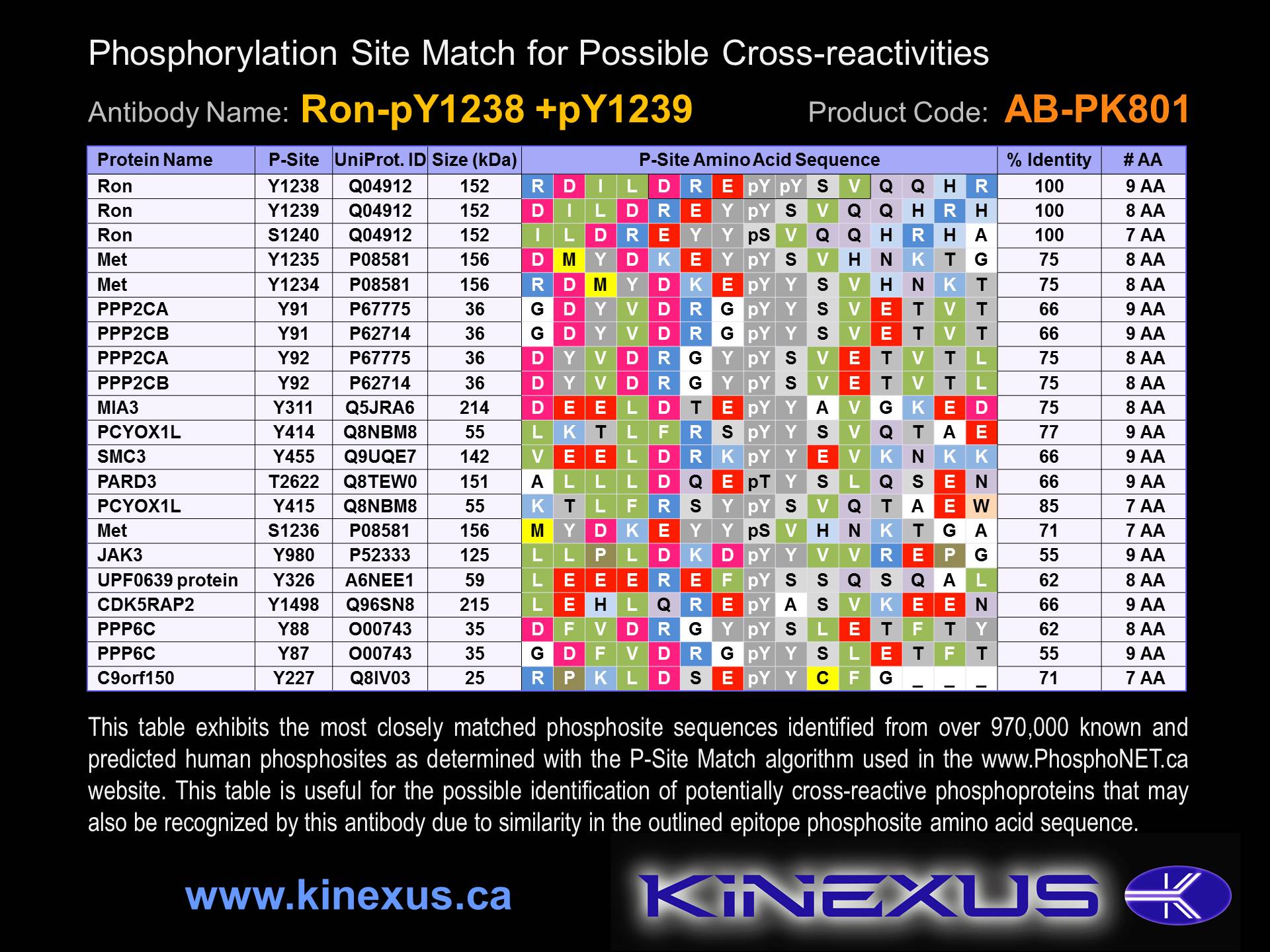Product Name: Ron-pY1238 +pY1239
Product Number: AB-PK801
| Size: | 25 µg | Price: | 89.00 | |
| $US |
Target Full Name: Macrophage-stimulating protein receptor alpha chain
Target Alias: CD136; CD136 antigen; CDW136; C-met-related tyrosine kinase; Kinase RON; Macrophage stimulating 1 receptor; Macrophage-stimulating protein receptor precursor; MSP receptor; MST1R; PTK8; STK; CCDS2807.1; ENSG00000164078
Product Type Specific: Protein kinase phosphosite-specific antibody
Antibody Code: PK801
Antibody Target Type: Phosphosite-specific
Antibody Phosphosite: Y1238 + Y1239
Protein UniProt: Q04912
Protein SigNET: Q04912
Antibody Type: Polyclonal
Antibody Host Species: Rabbit
Target Alias: CD136; CD136 antigen; CDW136; C-met-related tyrosine kinase; Kinase RON; Macrophage stimulating 1 receptor; Macrophage-stimulating protein receptor precursor; MSP receptor; MST1R; PTK8; STK; CCDS2807.1; ENSG00000164078
Product Type Specific: Protein kinase phosphosite-specific antibody
Antibody Code: PK801
Antibody Target Type: Phosphosite-specific
Antibody Phosphosite: Y1238 + Y1239
Protein UniProt: Q04912
Protein SigNET: Q04912
Antibody Type: Polyclonal
Antibody Host Species: Rabbit
Antibody Immunogen Source: Human Ron (RONa) sequence peptide Cat. No.: PE-04ADM99
Antibody Immunogen Sequence: DRE(pY)(pY)SV(bA)C
Antibody Immunogen Description: Corresponds to amino acid residues D1235 to V1241; In protein kinase catalytic domain activation T-loop between subdomains VII and VIII.
Antibody Immunogen Sequence: DRE(pY)(pY)SV(bA)C
Antibody Immunogen Description: Corresponds to amino acid residues D1235 to V1241; In protein kinase catalytic domain activation T-loop between subdomains VII and VIII.
Production Method: The immunizing peptide was produced by solid phase synthesis on a multipep peptide synthesizer and purified by reverse-phase hplc chromatography. Purity was assessed by analytical hplc and the amino acid sequence confirmed by mass spectrometry analysis. This peptide was coupled to KLH prior to immunization into rabbits. New Zealand White rabbits were subcutaneously injected with KLH-coupled immunizing peptide every 4 weeks for 4 months. The sera from these animals was applied onto an agarose column to which the immunogen peptide was thio-linked. Antibody was eluted from the column with 0.1 M glycine, pH 2.5. Subsequently, the antibody solution was neutralized to pH 7.0 with saturated Tris.This antibody was also subject to negative purification over phosphotyrosine-agarose.
Antibody Modification: Unconjugated. Contact KInexus if you are interest in having the antibody biotinylated or coupled with fluorescent dyes.
Antibody Modification: Unconjugated. Contact KInexus if you are interest in having the antibody biotinylated or coupled with fluorescent dyes.
Antibody Concentration: 1 mg/ml
Storage Buffer: Phosphate buffered saline pH 7.4, 0.05% Thimerasol
Storage Conditions: For long term storage, keep frozen at -40°C or lower. Stock solution can be kept at +4°C for more than 3 months. Avoid repeated freeze-thaw cycles.
Product Use: Western blotting | Antibody microarray
Antibody Dilution Recommended: 2 µg/ml for immunoblotting
Antibody Potency: Very strong immunoreactivity with immunogen peptide on dot blots.
Antibody Species Reactivity: Human
Antibody Positive Control: The observed molecular mass of the processed target protein on SDS-PAGE gels is reported to be around 150-220 kDa.
Storage Buffer: Phosphate buffered saline pH 7.4, 0.05% Thimerasol
Storage Conditions: For long term storage, keep frozen at -40°C or lower. Stock solution can be kept at +4°C for more than 3 months. Avoid repeated freeze-thaw cycles.
Product Use: Western blotting | Antibody microarray
Antibody Dilution Recommended: 2 µg/ml for immunoblotting
Antibody Potency: Very strong immunoreactivity with immunogen peptide on dot blots.
Antibody Species Reactivity: Human
Antibody Positive Control: The observed molecular mass of the processed target protein on SDS-PAGE gels is reported to be around 150-220 kDa.
Antibody Specificity: Very high
Antibody Cross Reactivity: No significant cross-reactive proteins detected in HeLa, HepG2 and Jurkat cells.
Related Product 1: Ron-pY1238 +pY1239 blocking peptide
Related Product 2: Ron-1 pan-specific antibody (Cat. No.: AB-NK161-2)
Related Product 3: Ron-2 pan-specific antibody (Cat. No.: AB-NK161-3)
Related Product 4: Ron-3 pan-specific antibody (Cat. No.: AB-NK161-4)
Related Product 5: Ron-pY1238 phosphosite-specific antibody (Cat. No.: AB-PK800)
Related Product 6: RonSubtide - RON protein kinase substrate peptide
Antibody Cross Reactivity: No significant cross-reactive proteins detected in HeLa, HepG2 and Jurkat cells.
Related Product 1: Ron-pY1238 +pY1239 blocking peptide
Related Product 2: Ron-1 pan-specific antibody (Cat. No.: AB-NK161-2)
Related Product 3: Ron-2 pan-specific antibody (Cat. No.: AB-NK161-3)
Related Product 4: Ron-3 pan-specific antibody (Cat. No.: AB-NK161-4)
Related Product 5: Ron-pY1238 phosphosite-specific antibody (Cat. No.: AB-PK800)
Related Product 6: RonSubtide - RON protein kinase substrate peptide
Related Product 7: IRS1 (979-989) KinSub - Insulin receptor substrate 1 (K979-G989, mouse) peptide; Insulin receptor substrate
Scientific Background: Ron (MST1R) is a protein-tyrosine kinase of the TK group and Met family. It is a receptor kinase that binds macrophage stimulating factor 1 (MST1, MSF) to propagate a cell migration, survival, or differentiation signal. This kinase is highly expressed and widely distributed in most tested human tissues. Phosphorylation of Ron at Y1198 and Y1288 increases phosphotransferase activity. Phosphorylation at S1394 induces interaction with 14-3-3 beta. Ron interacts with the HYAL2 receptor protein, rendering it functionally inactive. HYAL2 is a candidate tumour-suppressor glycosylphosphatidylinositol-anchored cell-surface protein that serves as an entry receptor for jaagsiekte retrovirus, a virus that causes contagious lung cancer in sheep that is morphologically similar to human bronchioloalveolar carcinoma. It was shown that Ron liberated from the association with HYAL2 becomes functionally active and activates the Akt and mitogen-activated protein kinase pathways. Ron has also been linked with the development of breast, head and neck, ovarian, renal and breast cancers, and pulmonary adenomas.
Figure 1. Dot blotting Ron-pY1238+pY1239 antibody with recombinant purified proteins.
Figure 2. Epitope mapping of Ron-pY1238+pY1239 antibody with similar phosphopeptides on dot blots.
© Kinexus Bioinformatics Corporation 2017




